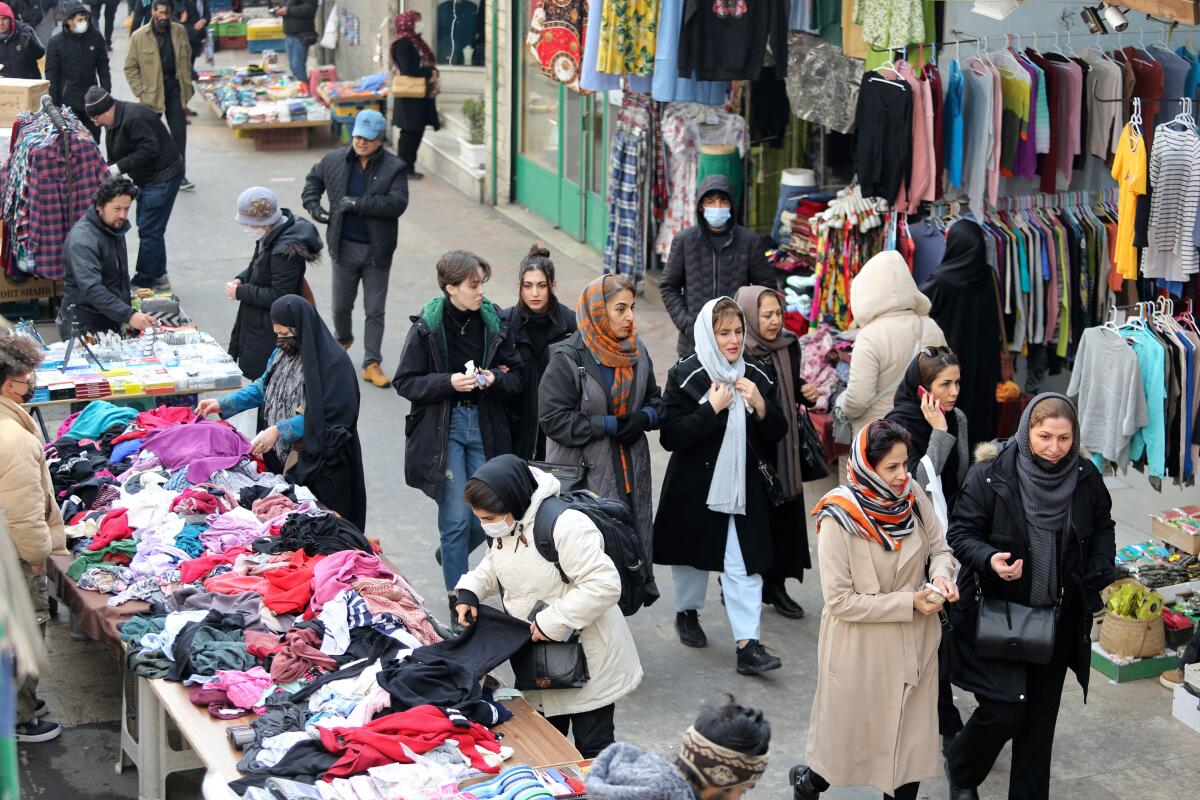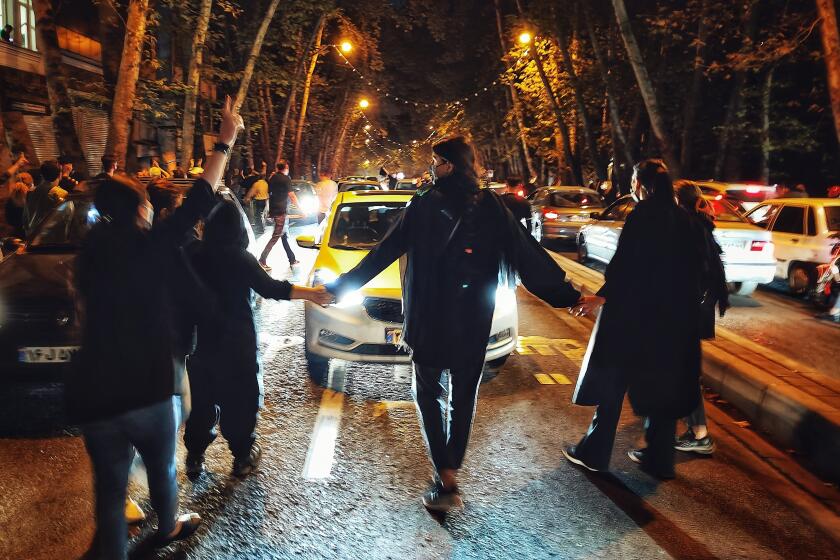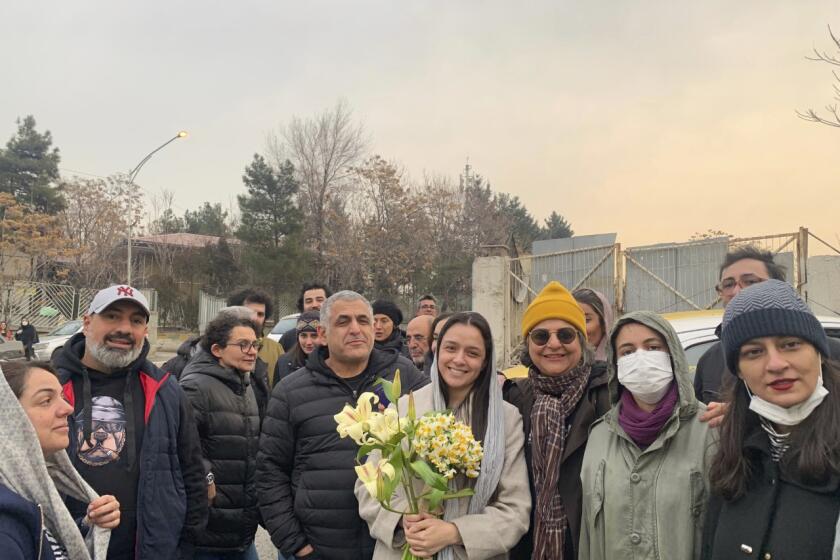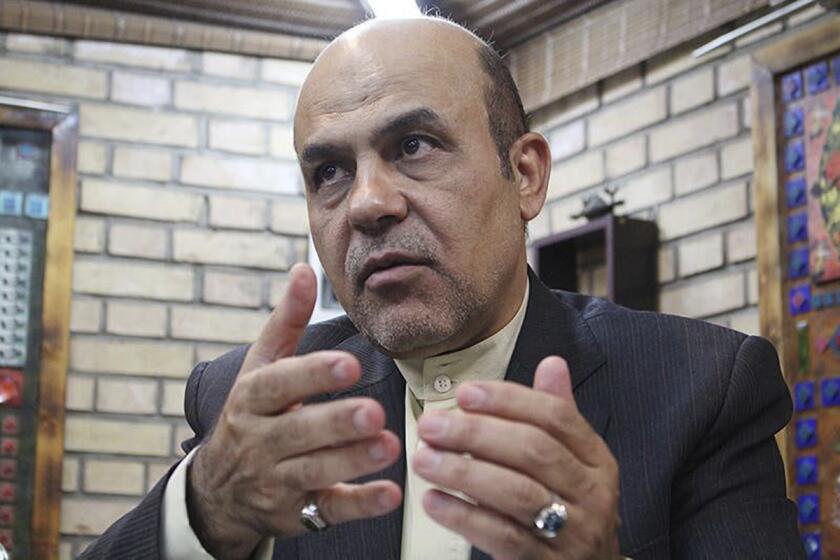Back to having no basics: Iranians tighten belts as the economy tanks and protests continue

- Share via
During a shopping trip to his neighborhood fruit market in the Iranian capital a few weeks ago, Abbas came to a realization: He couldn’t afford bananas. Since September, they had become twice as expensive, and were now another grocery item that was simply out of reach on his primary schoolteacher’s salary.
“The price of everything is doubling — it’s like there’s a drought in the country,” said Abbas, 45, who gave only his first name for safety concerns. “Basics like chicken we can’t get. Meat is way more expensive.”
The high prices have forced him to moonlight as a private tutor, but it’s still barely enough.
In the nearly five months since 22-year-old Mahsa Amini died in the custody of Tehran’s morality police, a tsunami of unrest has surged across Iran, with protests persisting despite a brutal crackdown by authorities and the threat of execution for demonstrators. Though women’s rights were the spark, the government now faces broader grievances, especially long-simmering resentments over the tanking economy and the evisceration of people’s finances.
Experts said the bleak economic situation has left Iranians all but tapped out after a decade of such challenges. But they doubted that growing discontent will translate into enough popular anger to seize power or even weaken the government’s ability to suppress dissent.
Though the protests have not died down, they have waned in scale and scope — for the simple reason “that the population cannot afford them,” said Ali Vaez, Iran project director for the International Crisis Group think tank. “The focus of the population has moved to making ends meet.”
Iran says it executed two men convicted of allegedly killing a paramilitary volunteer, the latest executions aimed at halting the nationwide protests.
Already-dire economic indicators have worsened even more in recent weeks. On the black market, the Iranian rial has stumbled to 443,500 to the dollar, a slight improvement from the all-time-low of 450,000 a few weeks ago but nowhere near the 300,000 mark before the protests began in September.
Inflation has surpassed 50%, the highest rate in decades. Food prices have risen by more than 70%. More than half of the young are unemployed. In early December, local commerce apps such as Sheypoor and Divar saw people trying to barter kitchen utensils, tools, toys and clothes for food.
“When I go shopping I have to be very selective,” said Negar, a 29-year-old homemaker who works part time in a nursery and who declined to give her last name. “Forget about steaks. I don’t buy olive oil anymore. Iranian rice is much more expensive.”
She and her husband could never hope to own the apartment where they live, which they can afford to rent only because her father-in-law pitches in. Before, she loved to entertain there, regularly hosting lunch and dinner gatherings for friends.
Taraneh Alidoosti, who starred in the Oscar-winning film ‘The Salesman,’ was jailed after criticizing Iran’s crackdown on antigovernment protests.
“Now there’s no way,” she said. “You have to give up your entire salary for a month.”
Economic malaise is not new in Iran, especially after 2018, when then-President Trump withdrew from Tehran’s nuclear deal with world powers and started a so-called maximum pressure campaign that made Iran one of the world’s most-sanctioned countries. Hopes that the Biden administration would revive the nuclear agreement and offer sanctions relief have not materialized.
The Iranian government’s brutal response to the protests has only exacerbated the economic woes.
When authorities employed internet shutdowns to prevent protesters from publishing videos of demonstrations, they devastated businesses across the country. Digikala, one of Iran’s largest e-commerce companies, saw its traffic quartered since the start of the protests; the government’s own estimates put losses to small and medium businesses at more than $1 billion.
Ali Reza Akbari’s hanging drew immediate anger from London, which along with the U.S. and others has sanctioned Iran.
Also ravaged were companies and brands deemed to have a connection to the ruling establishment. Mihan, one of the country’s largest dairy producers, whose trucks were filmed transporting riot police to demonstrations, faced such harsh boycotts that it made workers appear in videos on social media pleading for people to end their embargoes before the company went bankrupt and they lost their jobs.
Internationally, Tehran’s isolation has deepened, with the United States and Europe imposing new sanctions and strengthening enforcement of existing ones. The likelihood of a revival of the nuclear deal has further dimmed.
“That has created more negative projections within the business community in terms of the country’s economic prospects,” Vaez said.
Pessimism about the economy has spread to the wider population, said Esfandyar Batmanghelidj, founder of the London-based Bourse & Bazaar Foundation think tank.
Breaking News
Get breaking news, investigations, analysis and more signature journalism from the Los Angeles Times in your inbox.
You may occasionally receive promotional content from the Los Angeles Times.
“People are foreseeing the economic situation getting worse,” he said, adding that the rial’s fall against the dollar reflects the increasingly glum outlook. “It’s a barometer of economic sentiment in Iran. When the rial weakens, it’s an indication people are concerned about inflation, so they’re flocking to a safe haven, usually dollars.”
Dampened consumer demand is something Yahya, a 72-year-old shop owner in the western city of Kermanshah, sees every day.
“Companies are begging us to buy products, but we don’t place orders or stock goods because people are not buying,” said Yahya, who declined to give his full name. “Basics like rice and chicken are just not staple foods anymore.”
The government is trying to improve the situation. It appointed a new central bank governor in late December. Last week, it started selling gold coin securities on the stock market and pumped $305 million into the so-called NIMA market, an online system where Iranian exporters sell their foreign currency earnings to importers at a government-set rate.
The website of Iran’s judiciary said a Revolutionary Court sentenced Olivier Vandecasteele, a 41-year-old Belgian, during a closed-door trial.
This week, Iranian President Ebrahim Raisi — with Supreme Leader Ayatollah Ali Khamenei’s backing — pushed a privatization plan that would sell state assets in a bid to raise 1,080 trillion rials and help meet the country’s budgetary needs. Critics say that the expected proceeds are probably an overestimate and that asset sales would undoubtedly favor cronies of the regime.
In a speech last week declaring next year’s budget, Raisi promised that controlling inflation would be a priority. “Know that the prices of [foreign] currencies and gold, as well as the prices of many expensive things in the country, will decrease,” he said.
But he gave little detail how that would happen. In the meantime, critics say, the pillars of his economic plan to counteract Western sanctions — boosting Iran’s self-sufficiency and looking to Russia and China for the investments it cannot get from the West — have proved unsuccessful.
Although it has a more diversified economy than its also-oil-rich neighbors, Iran relies on imports for basic staples such as wheat. Russia has invested $2.7 billion in petroleum projects in Iran over the last 15 months, accounting for almost half of foreign investments, an Iranian official told local media; however, the official said Tehran was dissatisfied with Chinese investment, which amounted to a little less than $185 million over the same period.
More to Read
Sign up for Essential California
The most important California stories and recommendations in your inbox every morning.
You may occasionally receive promotional content from the Los Angeles Times.

















